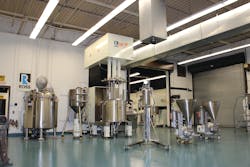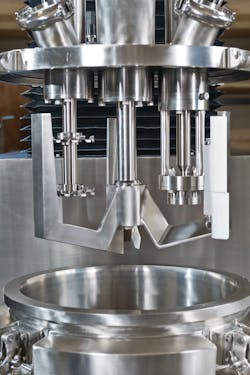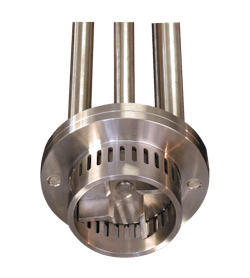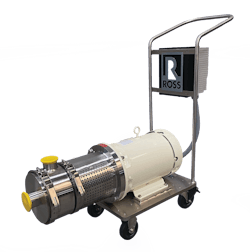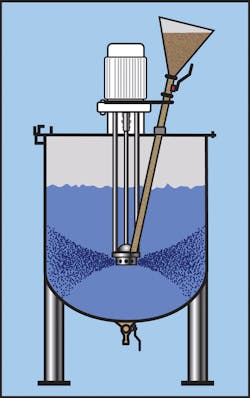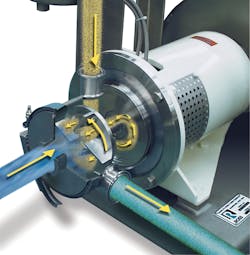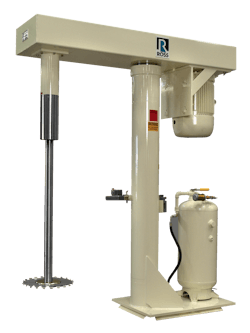My colleagues and I have recently been receiving a flood of inquiries from companies looking to quickly produce hand sanitizer. Many are small businesses starting up a new line, while others are companies that normally produce cosmetics or chemicals.
Universities, laboratories and contract manufacturers — and even distilleries — are stepping up to the plate during the COVID-19 pandemic. Amid this global health crisis, we are suddenly and acutely aware of the contributions of small and large manufacturers in providing items previously taken for granted. Before the pandemic, when was the last time we collectively gave a second thought to the production and supply of hand sanitizer, cleaning products, gloves, masks or toilet paper?
One silver lining is the response of the process industries to the crisis at hand — that of resilience and agility. I am fortunate to work for a 178-year-old manufacturer of mixing equipment, a New York-headquartered, employee-owned, family-started business that has survived wars, plagues, market depressions and recessions. We remain fully operational across all five United States plants and are proud to support critical infrastructure and essential industries such as food and beverage, pharmaceutical, chemical and more.
From paints and inks (when Brooklyn was a prominent paint manufacturing center in the early 1900’s), to smokeless gun powder (during World War I), to lubricants and body finishes (when the automotive industry took off), to cosmetics (when more women started wearing make-up in the 1930’s) and all the way to advanced adhesives, coatings and battery materials (in the internet and electronics age) — the sweeping number of applications that have shaped my company’s history, and more broadly the evolution of mixing technology itself, is obviously intertwined with the changing demands of society. Now and in the coming months, one of those demands is hand sanitizer.
In the thick of things
With that in mind, a short refresher on mixing thickeners seemed fitting. When making any gel-type product, proper mixing of rheology modifiers or thickening agents is a crucial step in the production process.
Thickeners may be classified into organic and inorganic groups. The organic group includes: cellulosic thickeners and derivatives (CMC, CMHEC, HEC, HMEC, HPC, HPMC, etc.); natural gums (agar, carrageenan, gelatin, pectin, xanthan, etc.); acrylate-based polymers; starches; stearates; fatty acid alcohols; waxes; and oils. Inorganic thickeners include clays, silicas and salts.
In particular, high-molecular-weight polyacrylic acids — also known as carbomers — are commonly used in all manner of personal care products including toothpaste, shampoo, lotions and hand sanitizers, to name a few. This class of thickeners requires neutralization to achieve maximum viscosity.
Rheology modifiers alter a system’s viscosity through a combination of mechanisms. In the case of carbomers, adding an alkali to an emulsion containing these tightly coiled polymers generates anionic charges along the chains — like charges repel causing the polymers to uncoil and swell to many times their volume. Another thickening mechanism is the interaction among the hydrophobic groups of the thickener. Particle-to-particle interactions between thickener and other components in the formulation also contribute to changes in rheological properties.
The actual mechanisms and combinations thereof are complex and vary from one application to another, but a common denominator is the need for proper dispersion or dissolution of the thickening agent at the right shear levels. The primary objectives of the mixing step are to provide a homogenous mixture and to expose as much surface area of the additive particles as possible. To achieve these goals mechanically, the batch must be subjected to ample shearing energy as the thickeners are being incorporated.
Processing pitfalls
The first apparent challenge is handling thickeners that come in the form of fluffy and dusty fine powders. To reduce the number of airborne particles in the mixing area, operators must carefully transfer the solids from their original container and into the mixing vessel.
Adding powders right on top of an agitated batch poses limitations. Most thickeners, due to their hydrophobic groups, resist wet-out upon contact with water, form lumps and float on the surface for long periods. This forces operators to sift and add powders only as fast as the liquid will take them. In lab-scale research and development, charging powders slowly into vigorously stirred liquid is not hard to accomplish in small quantities. But in a full-scale production setting, this method of addition can be very costly and time-consuming. Moreover, if powders are charged too slowly, an uncontrolled viscosity build-up can occur mid-processing and prevent the rest of the solids from being fully incorporated.
In contrast, manually adding the powders too fast can cause particles to clump up, as mentioned. These clumps — so called “fish eyes”— form a tough outer layer that prevents complete wetting of the interior particles. The high shear and turbulent flow conditions usually needed to break up these agglomerations can potentially overshear the already hydrated particles. Prolonged intense mixing may in fact damage the polymers and lead to permanent viscosity loss or other undesired rheological properties. In extreme cases, to shorten cycle times, operators resort to intentionally overdosing thickeners and filtering out the resulting “fish eyes.”
The above establishes that it is easy to mix thickeners inefficiently. Mixing intensity, rate and method of powder addition, cycle time, batch temperature, viscosity profile and raw material quality — these factors contribute to operational productivity, batch-to-batch consistency and revealing the full functionality of each ingredient.
Some solutions
One processing technique is to disperse carbomer powders into water under high shear in a dedicated mixing tank. The resulting dispersion is later blended with the alcohol phase and the rest of the ingredients in a main tank equipped with a low-speed propeller or anchor sweep. In the main tank, one of the final ingredients to be mixed in is the neutralizing agent (sodium hydroxide, potassium hydroxide or an amine base) which then initiates a rapid increase in gel viscosity. Dispersing the thickeners in a smaller tank eliminates the need for a large high shear mixer to fit the main tank, considering that the other product components do not require intense mixing. If thickeners are added directly to the main tank, operators must be mindful to switch to gentler agitation as soon as the powders are fully incorporated.
High shear mixers, characterized by a rotor/stator mixing head, are widely used for wetting out thickeners and preparing a fine dispersion. The classic design is characterized by a four-blade rotor running at tip speeds in the range of 3,000-4,000 ft/min within a close tolerance fixed stator. It creates mechanical and hydraulic shear by continuously drawing product components into the rotor and expelling them radially through the openings in the stator. High-shear mixers are available in both batch and inline designs.
In batch operations, the top-entering rotor/stator mixer is sized according to tank volume (or range of operating volumes, if intended for use on multiple vessels). For example, a 4” diameter rotor driven by a 10HP motor can handle low-viscosity batches (<20,000 cps) as small as 20 gallons and as large as 150 gallons. Within this approximate volume range and viscosity, the 10HP batch high shear mixer is able to produce adequate flow in a vessel with reasonable L/D ratio (1.2 to 0.8, ideally). As batch volumes become larger, bigger rotor/stator heads are required, and it is not uncommon to install an auxiliary propeller or anchor agitator to supplement bulk flow. Eventually, large-batch high shear mixers demand horsepowers that are prohibitive for many operations. In such cases, moving to a recirculating inline mixer set-up is more practical.
Externally installed, inline high shear mixers are less sensitive to tank size and geometry compared to their batch counterparts. For instance, a 10HP inline rotor/stator mixer set up for recirculation will pump around 240 gallons of process fluid per minute (based on water-like viscosity). It can shear material from a 1,500-gallon stirred tank as easily as it can shear product from a 150-gallon tote. The difference would simply be the total time required to achieve “X” number of passes through the mixing head. To ensure batch uniformity, recirculating for no less than ten theoretical passes is a good rule of thumb, in addition to applying some form of in-tank agitation as needed.
In the past, and even in recent years, some manufacturers have adopted eductor-based powder induction techniques in inline operations to combat excessive dusting and floating powder issues.
These systems operate based on the Venturi principle: a pump accelerates liquid into an eductor creating a vacuum; powder fed through an overhead tube is drawn by the vacuum into the eductor where it joins the liquid flow. Shortly after this “meeting point,” a rotor/stator device mixes the powder and liquid components, then propels the mixture downstream. The theory is sound, but in practice, balancing the performance of the pump, eductor and mixer is difficult. In many applications, downtime is high due to routine clogging. The system is temperamental and requires a lot of operator experience and attention to run successfully. With three separate devices in series, clean-up and maintenance can be demanding.
New generation high shear mixers address the above limitations by using a specially designed rotor/stator mixing head that also executes the functions of both the pump and the eductor. The ported rotor generates an intense vacuum which draws powders right into the high shear zone of the mix chamber, where they are dispersed instantly into liquid. An auxiliary pump and eductor are not required, making operation simpler and much more straightforward. Because solids and liquids are combined and mixed simultaneously right in the mixing head, agglomerates and clog-inducing materials are prevented from forming in the first place. Dispersion of thickeners and fillers including carbomers, cellulose, alginates, bentonite clay, xanthan gum, guar, carrageenan, pectin, fumed silica, starch, calcium carbonate, carbon black, titanium dioxide and talc — especially in large quantities — greatly benefit from eductor-less high shear mixer/powder injection systems.
Less demanding thickeners
Some thickening agents are easier to wet out than others. A saw-tooth disperser is not as shear-intense as a rotor/stator device but could work just as effectively. Running at tip speeds of around 5,000 ft/min, the disc-type disperser blade creates vigorous flow within the mix vessel and imparts greater shear compared to other open-blade mixing devices like propellers or turbines. It generates a vortex into which solids can be added for quick incorporation into the batch. The disperser blade may be located on- or off-center depending on the depth of the vortex (an off-center blade produces a smaller vortex and reduces air entrapment). As the batch thickens or increases in volume, blade speed is adjusted to maintain the vortex and rate of material turnover. Dispersers can generally handle viscosities up to around 50,000 cps.
Viscosity matters
Hydrogels for medical devices, injectable gels, topical drugs and other pharmaceutical-grade preparations commonly require processing in a closed-system, vacuum-rated mixer designed for accurate temperature control and efficient agitation at viscosities well over 100,000 cps. Depending on the viscosity range and shear requirement, multi-shaft mixers and planetary mixers are typically utilized for such high-end applications. Vacuum processing capability allows removal of air from the product, resulting in a smoother, air-free gel. Teflon scrapers constantly exchange materials from the sidewalls and bottom surfaces of the mix vessel, promoting batch homogeneity and accelerating heat transfer during any heating or cooling step.
Christine Banaszek is the sales manager at Charles Ross & Son Company, manufacturer of specialty mixing and blending equipment. As an application engineer at the corporate headquarters in Hauppauge, New York, she has worked at the Ross Test & Development Center and published many articles and whitepapers on mixing and blending technologies, applications and best practices.
